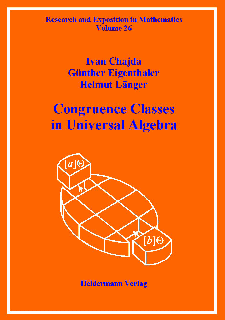Research and Exposition in Mathematics -- Volume 26
 Enlarged Picture
Enlarged Picture
I. Chajda, G. Eigenthaler, H. Lšnger
Congruence Classes in Universal Algebra
x + 218 pages, soft cover, ISBN 3-88538-226-1, EUR 28.00, 2003
Congruence relations play an important role when investigating universal algebras. On the
one hand, the structure of the congruence lattice of a given algebra reveals much information
on the underlying algebra. On the other hand, via congruence relations quotient algebras can
be formed which may have "nicer" properties than the original algebras. Moreover, in many
cases congruences are determined by some of their classes. For instance in the case of groups,
rings and Boolean algebras, congruences are determined by each single one of their classes.
The aim of the present book is to present the most important results concerning congruence
classes, dependences between them as well as connections to subalgebras. Thus the reader is
informed on the developments in this field during the last decades.
List of Contents:
| |
Preface |
ix |
| |
|
|
| |
1: Preliminaries |
|
| |
|
|
| |
2: Examples of algebraic structures | |
|
2.1 |
Ordered structures |
11 |
|
2.2 |
Groupoids and related algebras |
19 |
|
2.3 |
Ring-like algebras |
24 |
| |
|
|
| |
3: Congruence classes and subalgebras | |
|
3.1 |
Permutability |
27 |
|
3.2 |
Distributivity and modularity |
32 |
|
3.3 |
Direct decomposability |
35 |
| |
|
|
|
4: Congruence classes and subalgebras | |
|
4.1 |
Maltsev description of congruence classes |
39 |
|
4.2 |
Congruence classes which are subuniverses |
40 |
|
4.3 |
Subuniverses which are congruence classes |
41 |
|
4.4 |
Algebras having no proper subuniverse as a congruence class |
43 |
|
4.5 |
Hamiltonian algebras |
48 |
| |
|
|
|
5: Extension properties of congruence and their classes | |
|
5.1 |
Congruence extension property |
51 |
|
5.2 |
Block extension property |
54 |
| |
|
|
| |
6: Regularity and its modifications | |
|
6.1 |
Regularity |
57 |
|
6.2 |
Transferable congruences |
61 |
|
6.3 |
Regularity of single algebras |
61 |
|
6.4 |
Weak regularity |
64 |
|
6.5 |
Weakly regular algebras in varieties with principle compact congruences |
68 |
|
6.6 |
Local regularity |
71 |
|
6.7 |
Regularity with respect to unary terms |
76 |
|
6.8 |
Subregularity |
77 |
|
6.9 |
Dual regularity |
78 |
|
6.10 |
Balanced algebras |
80 |
| |
|
|
| |
7: Coherence and its modifications | |
|
7.1 |
Coherence |
85 |
|
7.2 |
Weak coherence |
87 |
|
7.3 |
Local coherence |
90 |
|
7.4 |
t-Coherence |
92 |
|
7.5 |
Uniformity |
93 |
|
7.6 |
Consistent algebras |
94 |
| |
|
|
|
8: Local congruence conditions | |
|
8.1 |
Permutability at 0 |
97 |
|
8.2 |
Distributivity at 0 |
99 |
|
8.3 |
Arithmeticity at 0 |
102 |
|
8.4 |
Modularity at 0 |
103 |
|
8.5 |
Weakly parallel classes |
108 |
|
8.6 |
Decomposability of kernels |
110 |
| |
|
|
| |
9: Characterizations of congruence classes | |
|
9.1 |
Congruence classes in regular and permutable varieties |
111 |
|
9.2 |
Congruence classes in regular varieties |
116 |
|
9.3 |
Congruence kernels |
119 |
|
9.4 |
Deductive systems |
120 |
|
9.5 |
Relative deductive systems |
123 |
|
9.6 |
Convex sets |
127 |
|
9.7 |
Congruence kernels in pseudocomplemented semilattices |
134 |
| |
|
|
| |
10: Ideals in universal algebras | |
|
10.1 |
Ideals and ideal determined varieties |
137 |
|
10.2 |
Ideals and congruence kernels |
141 |
|
10.3 |
Finite bases for ideal terms |
145 |
|
10.4 |
Ideal congruence properties |
151 |
|
10.5 |
Ideals in locally regular and permutable at 0 varieties |
155 |
|
10.6 |
Ideal extension property |
159 |
|
10.7 |
Ideals, congruence kernels and tolerance kernels of lattices |
160 |
| |
|
|
| |
11: Directly decomposable congruence classes | |
| |
|
|
|
12: One-block congruences | |
|
12.1 |
Semimodularity of one-block congruences |
185 |
|
12.2 |
Rees algebras and Rees varieties |
187 |
|
12.3 |
Rees ideal algebras and Rees ideal varieties |
189 |
|
12.4 |
Rees sublattices of a lattice |
192 |
| |
|
|
|
Bibliography |
197 |
| |
|
|
|
Index |
211 |
 Enlarged Picture
Enlarged Picture
 Enlarged Picture
Enlarged Picture